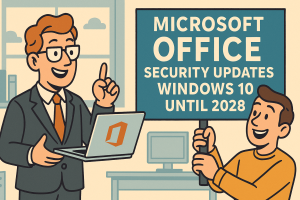 Microsoft will continue rolling out security updates for Microsoft 365 apps on Windows 10 until October 2028, extending support three years past the operating system’s planned end-of-life.
Microsoft will continue rolling out security updates for Microsoft 365 apps on Windows 10 until October 2028, extending support three years past the operating system’s planned end-of-life.
The change follows the company’s earlier position, announced in January, that Office apps would stop receiving updates on Windows 10 starting in October 2025. At the time, Microsoft urged users to upgrade to Windows 11 to maintain access to updated versions of Word, Excel, and other Microsoft 365 tools.
Microsoft has since reversed course. According to documentation updated in April, security updates for Microsoft 365 on Windows 10 will continue until October 10, 2028. These patches will be pushed through the usual Office update mechanisms.
Although Office apps will technically remain functional after Windows 10 support ends in October 2025, Microsoft warns that users may experience bugs, reduced performance, and reliability issues. Organizations running Microsoft 365 on Windows 10 are still encouraged to migrate to Windows 11.
Meanwhile, Office 2016 and Office 2019 are also approaching retirement. Both will lose extended support on October 14, 2025. Microsoft has posted migration guidelines to help businesses shift from these older versions to Microsoft 365.
Despite nearing its support cutoff, Windows 10 still holds a majority share among Windows installations. Recent data from Statcounter shows roughly 52% of Windows systems are running Windows 10, while just over 43% use Windows 11.
User resistance to Windows 11 upgrades remains tied to hardware requirements—specifically, the need for TPM 2.0. Microsoft has been promoting 2025 as the key year for Windows 11 upgrades, but adoption has lagged.
To ease the transition, Microsoft introduced a paid Extended Security Updates (ESU) program for Windows 10 Home users. Starting in October 2025, they can keep receiving critical patches for an additional year by paying $30.
Specialized editions of Windows 10, such as IoT Enterprise LTSC 2021 and 2016 LTSB, will continue to receive updates beyond the standard support window. These variants are designed for embedded systems and industrial environments where long-term stability is essential.